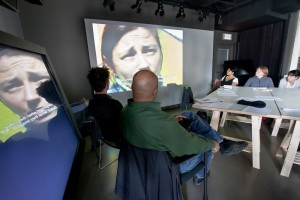
First meeting of the Curatorial Research Group!
The curatorial research group, consisting of the SSHRC Image, Text, Sound & Technology grant team “Curating Difficult Knowledge” (Erica Lehrer, Monica Patterson, Joseph Rosen, Cynthia Milton (U de M), Jason Lewis and Chris Salter), as well as a number of interested faculty and students from Concordia and McGill (Shelley Butler, Florencia Marchetti, Amber Berson, Ivet Reyes Maturano, Stacey Zembrycki) met to embark on what we hope will be an ongoing discussion of our shared interests and project ideas.
Our overall goal is to translate research based in empirical humanistic methodologies into innovative forms not usually seen in disciplines like history and anthropology. The idea is that such translation can not only produce new knowledge, but also can reach broader audiences and bring them into dialogue with researchers.
While we come with different core interests, we meet at the intersection of these three overlapping concerns:
1) “Difficult knowledge” – painful and contested subject matter & how to deliver it in transformative ways
2) Translating theory & criticism into exhibition and installation
3) Collaboration
Aside from beginning to think collectively and tinker in the lab, two of our main challenges are:
1) Devising effective methods of collaboration among diverse researchers;
2) Figuring out how to create knowledge products that can speak to the various perspectives of our different scholarly realms. (So how to make an installation register, or be legible as meaningful scholarship to both computational arts and the history department).
Finally, it was fascinating to hear about the approaches and ideas the group brought to the table. For example, can experimental curatorial work:
- Get suppressed/forgotten information (especially visual information) about the past back into public cultural memory?
- Help transform ethnic/national identity positions?
- Tell stories that are not sequential, to recognize multiple dimensions of memory?
- Offer new ways for groups who were historically represented in exhibits and displays represent themselves?
- Link communities together in extended dialogue and exchange?
To be continued!
Post by Erica Lehrer.



